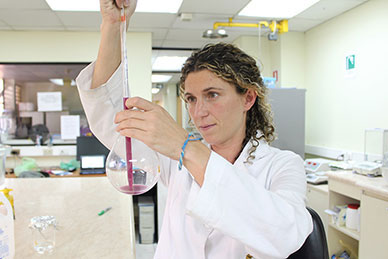- A plastic bag takes 1,000 years to break down. In light of this situation, biodegradable materials have become a good option. This is the context in which the study led by Dr Ana Carolina López Dicastillo, a member of the Center for the Development of Nanoscience and Nanotechnology of Universidad de Santiago, is being conducted. Thanks to the electrospinning technique, her research team will produce nanoparticles able to enhance the properties of biodegradable materials in order to obtain, in the long term, more eco-friendly packaging.
It is widely known that a plastic bag takes 1,000 years to break down, causing harm to the environment. Biodegradable materials are an alternative to solve this problem, because they are highly beneficial to the environment when they are adequately discarded. However, these materials do not have the same barrier and mechanical properties that petroleum-based products do, so they become fragile and highly permeable.
Thanks to the electrospinning technique, the research team will produce nanoparticles able to enhance the properties of biodegradable materials in order to obtain, in the long term, more eco-friendly packaging. The study is led by Dr Ana Carolina López Dicastillo, a member of the Center for the Development of Nanoscience and Nanotechnology of Universidad de Santiago, (Cedenna, in Spanish).
This Regular Fondecyt project, which is in its second year, seeks to improve the properties of a biodegradable material by incorporating nanoparticles produced by electrospinning to eventually use this material for food packaging. The electrospinning technique has not been frequently used in our country.
The electrospinning process allows obtaining fiber by means of the coaxial stretching of a viscoelastic solution. The diameter of the electrospun fibers ranges from microns no nanometers and they may have unique features.
Due to its interesting properties, this technique has been widely studied in the past few years for a wide variety of applications, like tissue engineering, the creation of special membranes and medical applications like dental implants and bone replacement. In this case, the project is oriented to enhance the properties of biodegradable materials for food industry applications. “Besides developing and working with nanoparticles and nanofibers, this technique allows encapsulating active compounds for their further release, what is also important in the food industry,” Dr López said.
The study seeks to enhance the essential properties of a biodegradable polymer and to create a biodegradable packaging with antioxidant and antimicrobial properties to protect food and to extend its shelf life.
Dr. López Dicastillo, who is responsible for the study, explains that “one of the expectations that we have with this work is trying to implement the concept of reducing plastic products in daily life, replacing traditional materials with biodegradable ones and the awareness of recycling and sustainability.”
She has the goal of making people aware of the problem posed by the plastic waste buildup and the need for replacing petroleum-based products with biodegradable materials, as petroleum is not a renewable resource.
“However, these (biodegradable) materials do not have the properties that the market demands yet. This is why we propose to enhance them and one of the solutions to this problem is nanotechnology. In our project, we are developing a type of nanoparticle that can make biodegradable materials properties to be similar to the ones of traditional plastic products in the market,” she said.
“We also intend to disseminate this study at different levels: from teaching children the importance of these existing biodegradable materials, emphasizing the need for recycling, to scientific conferences and presentations,” the researcher concluded.
Translated by Marcela Contreras



